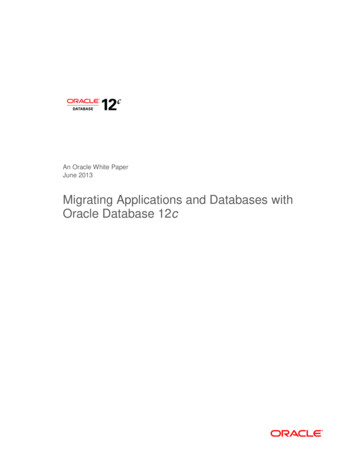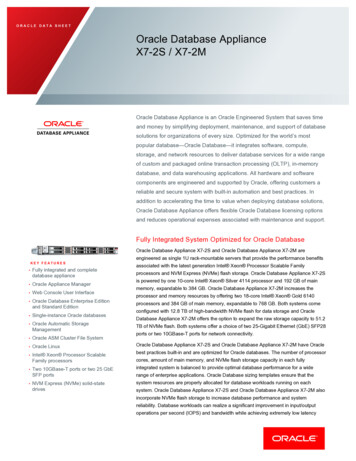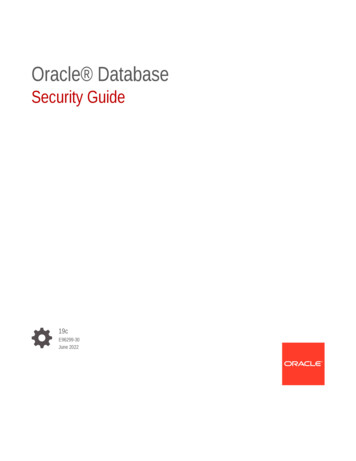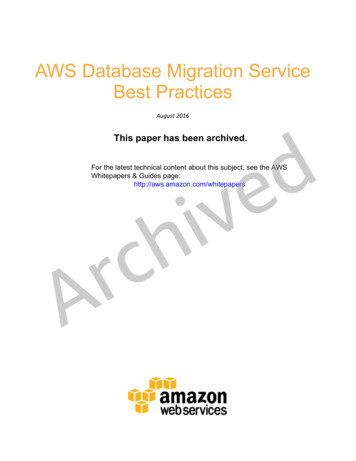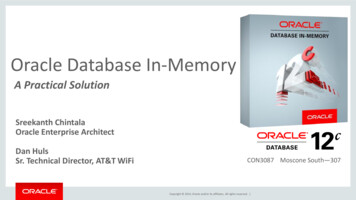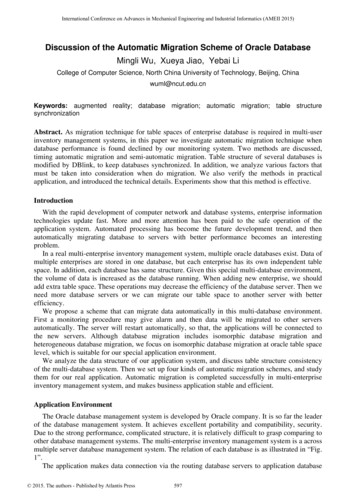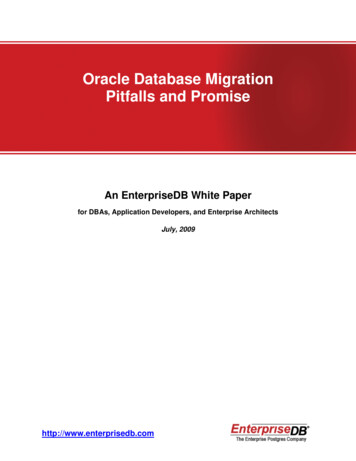
Transcription
Oracle Database MigrationPitfalls and PromiseAn EnterpriseDB White Paperfor DBAs, Application Developers, and Enterprise ArchitectsJuly, 2009http://www.enterprisedb.com
Oracle Database Migration Pitfalls and Promise2Executive SummaryEnterprises have a variety of reasons for wanting to migrate applicationsfrom one database platform to another including reducing license feecosts, simplifying heterogeneous architectures, or taking advantage ofnew technologies.For technical reasons, migrations are difficult, costly, and risky because ofthe use of many vendor proprietary database features integrated into theonce ‘standard’ platform of SQL. In addition, the re-training effort forpeople and subsequent difficulty in re-coding applications and testing thechanges often don’t cost justify the benefits of the move. The result isvendor lock-in.Previous vendor attempts at database compatibility have fallen far short ofbridging the migration gap because of a server side only focus on easilytranslated features, poor success at finding analogs for proprietaryfeatures, a lack of application level compatibility (procedural languagesand APIs), and a lack of compatible tools for DBAs and Developers.Postgres Plus Advanced Server from EnterpriseDB solves the migrationproblem with compatibility in SQL Extensions, the Procedural Language,DBA and Developer tools, application APIs, and migration tools for Oracledatabase applications. This approach makes for significantly fastermigrations, dramatically reduced re-coding efforts, shorter learning curves,significantly less risk, and ultimately a beneficial justification for making themove.This paper contains an actual walk-through of migrating an Oracle sampleschema and provides step by step instructions on how to get ready for amigration, select what to migrate, perform the migration, and setup theapplication to talk to the new database.A free telephone consultation can be scheduled with an EnterpriseDBOracle compatibility expert who can quickly help you to determine thequickest, safest path to a justifiable migration. If appropriate, a migrationfeasibility assessment can be performed on your Oracle databases. EnterpriseDB Corporation, 2009 All rights reserved.EnterpriseDB and Postgres Plus are trademarks of EnterpriseDB Corporation. Other names may be trademarks of their respective owners.http://www.enterprisedb.com
Oracle Database Migration Pitfalls and Promise3The Roots of Vendor Lock-inIn order to reduce costs, simplify IT infrastructures, or to take advantage ofnew technology, companies regularly investigate or attempt to move fromone database platform to another. This is not a new idea or movement asit has been happening in some fashion for many years. The difficulty thatcompanies have faced with this process which in many cases preventedsuch a movement, is that migrations are not easy.Although most commercial database products support some level of ANSISQL, applications built for those products are far from portable. Databasevendors have implemented unique data types and functions, proprietaryAPIs, stored procedure languages, command constructs and utilities thatcollectively eliminate the very portability ANSI SQL strives to achieve.As application developers and DBAs learn to navigate those interfacesand deploy database applications that embed those proprietaryconstructs, vendors reach a significant level of technology lock-in. Whencustomers try to migrate to a new database platform, they realize thatthere are substantial changes that need to be made to both the databaseand the application that results in a long and difficult process whose costsoften don't justify the benefits of move.History has proven that, once a vendor is locked in and is no longermotivated to compete for a seat at the IT table, bad things often happen prices increase, support levels deteriorate and innovation stagnates.The Struggle for Database CompatibilityA compatible database is one that claims to offer the same functionality asanother database vendor. If the compatibility is adequate enough, thenthe problems of traditional migrations are avoided since the new databasesupports the same syntax, languages and functionality of the originaldatabase. Thus the cost of the migration (the term migration is notcompletely accurate since this is more like a port), is substantially reducedsince the timeframe and effort involved is only a fraction of the originalcost.Database and third party vendors have made valiant attempts to producemigration tools to help you convert databases automatically in a somewhatsimplistic and mechanical fashion. Migration tools are good at takingstandard syntax from one language and converting it into the standardsyntax of the new database. EnterpriseDB Corporation, 2009 All rights reserved.EnterpriseDB and Postgres Plus are trademarks of EnterpriseDB Corporation. Other names may be trademarks of their respective owners.http://www.enterprisedb.com
Oracle Database Migration Pitfalls and Promise4The problem is that all database vendors offer different semanticfunctionality and thus one way of doing something may not translate intoeasily or completely into the new database. Thus manual intervention orrecoding is necessary.Migration tools also don't have human intelligence to decide that simplyconverting syntax to syntax may not be the best performing result either.So, even after the tool converts the code, manual intervention isnecessary. These tools also can't guarantee the converted code willactually execute the same way as the original code and thus potentiallyreturn incorrect results!In addition, these migration tools typically focus on the server / databaseside and completely ignore the application and any embedded SQL orcalls to stored functions. This becomes the customer’s responsibility toanalyze and manually modify the application logic.Other obstacles related to different database functionality include stafflearning curves to understand the differences and learning the skillsneeded to operate different toolsets. Thus the database administratorsand database developers need to be trained and educated on thecapabilities / functionality of the new database. That takes time andmoney.The time, energy and ultimately cost of the migrations become sounbearable that the migration project is typically shutdown even before itgets started.The Importance of a Migration StrategyAnother impediment to database migrations is the lack of a well definedlow risk low cost strategy for moving an enterprise from one database toanother over time. EnterpriseDB, in working closely with customers overmany years, has identified a working pattern of success for introducingnew database technology into an existing legacy architecture.The strategy is characterized by starting with low risk, easy to executeprojects that demonstrate technical, financial and human feasibility inintroducing an Oracle compatible technology into the organization.The table below summarizes a successful approach to introducingPostgres Plus Advanced Server into an enterprise with legacy technologyand skill sets. EnterpriseDB Corporation, 2009 All rights reserved.EnterpriseDB and Postgres Plus are trademarks of EnterpriseDB Corporation. Other names may be trademarks of their respective owners.http://www.enterprisedb.com
Oracle Database Migration Pitfalls and Promise5StrategyDevelop / DeployNew LOB Applicationson Postgres PlusAdvanced ServerDeploy AdvancedServer as an OracleReplication ServerMigrate non-MissionCritical OracleApplications toAdvanced ServerMigrate Mission CriticalOracle Applications toPostgres PlusAdvanced ServerBenefits Significant cost savings for non missioncritical systemsLeverages all existing Oracle skillsVery low riskSignificant cost savingsLeverages Postgres Plus Replication ServerLeverages all existing Oracle skillsImproves OLTP and query performanceSignificant cost savingsLeverages all existing Oracle skillsVery low risk Biggest cost savingsLeverages all existing Oracle skillsGreatest deployment flexibilityEnterpriseDB Database CompatibilityEnterpriseDB has made years of extensive investments enhancingPostgres Plus Advanced Server to run applications written for Oracle. Theextent of the compatibility is proven in an almost push button conversionfor many Oracle applications migrated to Postgres. The enhancements fallinto the following broad categories: SQL Extensions Compatibility. Database vendors have uniqueSQL language extensions to differentiate their products. PostgresPlus Advanced Server understands Oracle's SQL extensions suchas decode(), the DUAL table, and ROWNUM.Procedural Language Compatibility. Postgres Plus AdvancedServer's procedural language is compatible with Oracle's PL/SQLfor triggers, stored procedures, packages, functions and databaseinternals like Wait Events. Developer re-training and application rewriting are non-existent to minimal, saving valuable time andconversion costs while reducing migration risk.Tools Compatibility. DBA tools like SQL*Plus, SQL*Loader, DBAManagement Server, and DBLinks are all supported in PostgresPlus Advanced Server. These emulated features allow DBAs toavoid re-training and re-use their Oracle skill set. Even the mostcommon Oracle catalog views are supported.Application Support. EnterpriseDB supports the most commonprogramming languages used to create applications for Oracle. EnterpriseDB Corporation, 2009 All rights reserved.EnterpriseDB and Postgres Plus are trademarks of EnterpriseDB Corporation. Other names may be trademarks of their respective owners.http://www.enterprisedb.com
Oracle Database Migration Pitfalls and Promise 6Also, Postgres Plus Advanced Server has built in support for theOCI, assuring you that applications written in C or C will still run.Migration Tools. Functional compatibility is great but not if theconversion effort is cost prohibitive. Postgres Plus AdvancedServer provides automated tools to move Oracle schema, data,packages, triggers, stored procedures, and functions to PostgresPlus Advanced Server in one step.EnterpriseDB's Postgres Plus Advanced Server products offers Oraclecompatibility to a degree never seen in other databases. The migrationtoolset simply takes Oracle objects and recreates them automatically inthe Postgres Plus Advanced Server database. The tool will also migrateyour data so a minimal amount of manual work is necessary.An Oracle Migration Walk-ThroughThis section presents the steps involved in an Oracle to Postgres PlusAdvanced Server migration. In general a migration progresses through thefollowing high level phases: on PreparationIn this first phase of the migration process, the servers and software aresetup and configured. The setup requires the target Postgres PlusAdvanced Server to be installed on a server with network connectivity tothe source Oracle server. EnterpriseDB Corporation, 2009 All rights reserved.EnterpriseDB and Postgres Plus are trademarks of EnterpriseDB Corporation. Other names may be trademarks of their respective owners.http://www.enterprisedb.com
Oracle Database Migration Pitfalls and Promise7After installing Advanced Server and starting the server, you need to copythe Oracle JDBC jar file from the Oracle installation directory to the jre/extdirectory in the Postgres Plus Advanced Server home directory. Puttingthe jar file in this directory enables the Migration Studio tool to find thedriver and use it to connect to Oracle. The following steps illustrate thisprocess.Step 1: Prepare Connection to OracleIn this step, the Oracle JDBC driver is copied from the Oracle databasehome to the appropriate directory in the Advanced Server home directory.Change into the Oracle home directory, in this case we are using OracleXE version 10.2.0 and locate the JDBC directory. The driver is located inthe lib subdirectory as shown below:Next, the ojdbcX.jar file is copied to the jre/lib/ext directory in the PostgresPlus Advanced Server home: EnterpriseDB Corporation, 2009 All rights reserved.EnterpriseDB and Postgres Plus are trademarks of EnterpriseDB Corporation. Other names may be trademarks of their respective owners.http://www.enterprisedb.com
Oracle Database Migration Pitfalls and Promise8Once the JDBC jar is in place the Migration Studio tool is ready toestablish a connection to the source Oracle database.Step 2: Establish Oracle ConnectionsStart up the EnterpriseDB Migration Studio by selecting 'Migration Studio'from the Postgres Plus Advanced Server 8.3R2 Program group in theStart menu.Once the Migration Studio is started, a connection to Advanced Serverneeds to be added if it is not already configured. Right Click on Serversand select 'Add Server' and then click on the New button in the AddServer dialog. Enter the Postgres Plus Advanced Server connectioninformation for your database as illustrated below: EnterpriseDB Corporation, 2009 All rights reserved.EnterpriseDB and Postgres Plus are trademarks of EnterpriseDB Corporation. Other names may be trademarks of their respective owners.http://www.enterprisedb.com
Oracle Database Migration Pitfalls and Promise9To ensure that the connection information entered is correct, the Testbutton is used which produces the following dialog when the connection isworking:Then the Oracle database connection needs to be setup. Right click onServers again and click New. EnterpriseDB Corporation, 2009 All rights reserved.EnterpriseDB and Postgres Plus are trademarks of EnterpriseDB Corporation. Other names may be trademarks of their respective owners.http://www.enterprisedb.com
Oracle Database Migration Pitfalls and Promise10In the Server Type pull down menu, select Oracle. Then enter the Oracleconnection information:Test this connection to make sure everything is working and you shouldsee the success message again.As a final task in the preparation phase, the objects to be migrated need tobe determined. The Migration Studio has the capabilities to migrate entireschemas, groups of objects such as all tables or individual objects. Thefollowing illustrates how Migration Studio is used to browse an Oracledatabase and choose what objects to migrate.Step 3: Browse and Choose Oracle Objects to Migrate EnterpriseDB Corporation, 2009 All rights reserved.EnterpriseDB and Postgres Plus are trademarks of EnterpriseDB Corporation. Other names may be trademarks of their respective owners.http://www.enterprisedb.com
Oracle Database Migration Pitfalls and Promise11Using the object browser one can navigate from the Oracle databaseconnection folder to the Databases folder and finally the schema folder.For this example, we will be using the sample HR schema that is includedwith all Oracle XE installations. This schema contains 7 tables, 2procedures, 1 view, 2 triggers and 3 sequences.If you continue to expand the HR schema folder, you will see folders for allthe tables, views, packages, procedures, functions and sequences in theHR schema as show below.By highlighting the HR folder, the entire HR schema can be migrated butyou have the choice to migrate individual objects or groups of objects.The decision to move only the schema / object definitions or move thedata as part of the migration needs to be made. The Migration Studiooffers the ability to move the data separately from the schema / objects. Itis recommended that the first pass through the migration be done with theschema / objects only and then once that part is complete, return andmigrate the data.The reason for this 2 step process is to allow you time to resolve anyissues with the schema / object creation that might affect the data load.For instance, one possible issue is if a column name from the Oraclesystem is a reserved word in Postgres Plus Advanced Server. If this wereto happen, the table creation would fail and thus the data load would failas well. EnterpriseDB Corporation, 2009 All rights reserved.EnterpriseDB and Postgres Plus are trademarks of EnterpriseDB Corporation. Other names may be trademarks of their respective owners.http://www.enterprisedb.com
Oracle Database Migration Pitfalls and Promise12Migration ExecutionThe process of performing the migration is very straightforward. At thispoint, the Migration Wizard, which is part of the Migration Studio would beutilized. The following steps illustrate a two step migration where theschema/object definitions are migrated first and then, if successful, thedata is moved.Step 1 Open the Migration WizardOnce the schema / object to be migrated is found in the browser, rightclick on the object name or folder name and choose 'Online Migration'.This will display the Migration Wizard dialog.The Migration Wizard contains choices for : The target Postgres Plus Advanced ServerThe destination database in that serverThe source schema to be migrated (the same schema will becreated in the destination database)The delimiter used to separate columns of data during the migrationMigrating schema and data or just the schemaTypically, the only changes you will make here are: Changing the delimiter character if you know the default delimiteroccurs in your data, orSelecting Definition Only if you plan to migrate the schema first andreturn later for the data.The following figure shows that the source HR schema is about to bemigrated to the Postgres Plus Advanced Server running on the localhoston port 5444. The migrated HR schema will be created in the edbdatabase. If you wish to migrate to a different database in this cluster, youcan choose the database from the drop down menu.The default delimiter is acceptable in this walk-through since it does notexist in our data. Since we are illustrating a two step migration, the'Definition Only' check box has been checked. EnterpriseDB Corporation, 2009 All rights reserved.EnterpriseDB and Postgres Plus are trademarks of EnterpriseDB Corporation. Other names may be trademarks of their respective owners.http://www.enterprisedb.com
Oracle Database Migration Pitfalls and Promise13Once you are ready to start the migration, click Run. The migration will beperformed and a running log of the tools activity will be displayed.Scrolling down to the bottom of the log allows you to see a messageindicating the success of the migration. EnterpriseDB Corporation, 2009 All rights reserved.EnterpriseDB and Postgres Plus are trademarks of EnterpriseDB Corporation. Other names may be trademarks of their respective owners.http://www.enterprisedb.com
Oracle Database Migration Pitfalls and Promise14After the Migration Wizard completes, the migration log should bereviewed to check for errors that might have occurred.Errors during the migration typically fall into the following categories: Reserved word conflictsFeature implementation differencesFeatures not currently supported EnterpriseDB Corporation, 2009 All rights reserved.EnterpriseDB and Postgres Plus are trademarks of EnterpriseDB Corporation. Other names may be trademarks of their respective owners.http://www.enterprisedb.com
Oracle Database Migration Pitfalls and Promise15Reserved word conflicts occur when a column of a table is named with areserved word used in Postgres Plus Advanced Server. Common casesof this include the words time and date. The workaround is to eitherchange the name of the column, (i.e. use time c) or put the column namein double quotes (“date”).Feature implementation differences refer to features that both databasessupport but with different syntax. For example, both databases supportrange and list partitioning but the syntax and steps to create a partitionedtable are different in each database. In this case, the Migration Wizardmigrates the table as a Postgres partitioned table using the correct syntaxand functionality available in Postgres Plus Advanced Server.Other feature implementation differences include full text search or spatialdata support. The Postgres database has had support for these featuresfor quite some time but the implementation is quite different than Oracle'sand thus the Migration Wizard is not able to migrate the functionality over.It does migrate the data(the text data) over but you may need to changethe data types to take more optimal advantage of the Postgresfunctionality.Then there are the features that Postgres Plus Advanced Server simplydoesn't support yet. Features in this category include things likeAutomatic Storage Management (ASM), Flashback database, databaseresource manager, table compression,Advanced Queuing, external tables,materialized views and analytic functions.Automatic Storage Management(ASM) is the ability of the database to actas it’s own volume management system. Postgres doesn’t have this andrelies on the volume management system of the hardware for thisfunctionality.Table compression can be accomplished by putting those tables in atablespace that resides on a compressed filesystem. This is supported byPostgres.Advanced Queuing, although not built into the database can be and hasbeen worked around using external messaging systems such asActiveMQ, TIBCO or MQ Series so those are options for you if you useAQ.External tables will need to be loaded into staging tables in the database.Using EnterpriseDB’s EDB*Loader tool to load the data quickly is therecommended approach.Materialized views exist in the form of summary tables that can bemaintained by triggers, similar to the Oracle implementation but the setup EnterpriseDB Corporation, 2009 All rights reserved.EnterpriseDB and Postgres Plus are trademarks of EnterpriseDB Corporation. Other names may be trademarks of their respective owners.http://www.enterprisedb.com
Oracle Database Migration Pitfalls and Promise16is manual and not Oracle compatible. Automatic query rewrite is notcurrently supported so your application will need to be made aware of thesummary table’s existence.Analytic Functions like lag, lead and dense rank are not supported in the8.3x releases of Postgres Plus Advanced Server. These have beenintroduced in the PostgreSQL 8.4 release so they will be available in the8.4 release of Postgres Plus Advanced Server.If errors are encountered during migration, EnterpriseDB can be quicklynotified by emailing us at migrations@enterprisedb.com.We arecontinuously enhancing our compatibility and input from customers isinvaluable in helping us prioritize our development plans and helpingcustomers troubleshoot new issues.After any errors are resolved and the schema / objects are successfullymigrated, it is time to migrate the data from the Oracle database toPostgres Plus Advanced Server. This process is similar to the earliermigration step only this time you will navigate to the Table folder in thebrowser and right click on that Table folder. EnterpriseDB Corporation, 2009 All rights reserved.EnterpriseDB and Postgres Plus are trademarks of EnterpriseDB Corporation. Other names may be trademarks of their respective owners.http://www.enterprisedb.com
Oracle Database Migration Pitfalls and Promise17After choosing Online Migration you will once again be entering theMigration Wizard. As you will see, there is only a slight change in its look.You will want to check the box next to 'Data Only' as shown below. EnterpriseDB Corporation, 2009 All rights reserved.EnterpriseDB and Postgres Plus are trademarks of EnterpriseDB Corporation. Other names may be trademarks of their respective owners.http://www.enterprisedb.com
Oracle Database Migration Pitfalls and Promise18Once this is done, select Run and the data migration will begin. Again,check the log for any errors that may have occurred during the datamigration. EnterpriseDB Corporation, 2009 All rights reserved.EnterpriseDB and Postgres Plus are trademarks of EnterpriseDB Corporation. Other names may be trademarks of their respective owners.http://www.enterprisedb.com
Oracle Database Migration Pitfalls and Promise19The amount of time that the migration takes will be dependent on theamount of data to be moved and the speed of the connection between thetwo databases. For larger databases, another method of moving the datacan be used that uses Oracle's native OCI connectivity instead of JDBC.This can speed up the migration substantially.In order to use the OCI connectivity, you will need to setup one of theforms of database links that Postgres Plus Advanced Server supports, i.e.dblink ora or Oracle style database links. The decision as to which typeof link to use will depend on which version of Postgres Plus AdvancedServer you are using as the Oracle database links are only supported inversion 8.3. Setup of these database link methods require additionalsteps that are outside of the scope of this paper. If you would like to learnmore about these methods, please contact an EnterpriseDBrepresentative at migrations@enterprisedb.com.There are rarely any errors during the data migration. The most commonerror encountered at this stage is when the chosen delimiter occurs in thedata resulting in an error for each offending row (usually stating that extracharacters were found at the end of the record).Care needs to be taken to choose the proper delimiter. The defaultdelimiter is a pipe ' ' and that works in the majority of the cases. If there isa failure due to this delimiter choice and you need to try another delimiter,simply go back into the Migration Studio, browse to the offending table,right click on the table name, choose Migration Wizard, change thedelimiter and run the migration process again.Migration ValidationYou can now browse the Advanced Server database and see the migratedobjects. EnterpriseDB Corporation, 2009 All rights reserved.EnterpriseDB and Postgres Plus are trademarks of EnterpriseDB Corporation. Other names may be trademarks of their respective owners.http://www.enterprisedb.com
Oracle Database Migration Pitfalls and Promise20You can select a table name, for example employees, and right click on itand choose 'View Data' from the popup menu. This brings up the built inSQL Interactive tool and allows you to run queries and view the data in themigrated table. EnterpriseDB Corporation, 2009 All rights reserved.EnterpriseDB and Postgres Plus are trademarks of EnterpriseDB Corporation. Other names may be trademarks of their respective owners.http://www.enterprisedb.com
Oracle Database Migration Pitfalls and Promise21An additional task that should be performed to validate the success of themigration from a database point of view is to run SQL statements in bothOracle and Postgres Plus Advanced Server, gather the record counts ofeach table. Assuming the data in Oracle hasn't changed, these recordcounts should be equal.Migration TestingValidating the migration from a database point of view is only one part ofthe necessary testing. A vital part of proving that the migration wassuccessful is to test the new system using the same application that wasused against the source Oracle system. This step obviously involves theporting of the application so that it can connect to Postgres Plus AdvancedServer. For Java applications, that simply involves changing the JDBCdriver and the connection URL. For ODBC applications, create anEnterpriseDB data source and tell the application to use it instead ofOracle's datasource.One common concern or question asked bycustomers is 'What about the embeddedapplication?'. Advanced Server contains aunderstands the Oracle flavor of SQL and thethat Oracle has added to its SQL support.statements don't need to modified!many potential migrationSQL statements in mycompatibility parser thatmajority of the extensionsThus, those embedded EnterpriseDB Corporation, 2009 All rights reserved.EnterpriseDB and Postgres Plus are trademarks of EnterpriseDB Corporation. Other names may be trademarks of their respective owners.http://www.enterprisedb.com
Oracle Database Migration Pitfalls and Promise22Other applications such as those written in C would require additionalsteps depending on which Oracle API it was coded to utilize. For moreinformation on this topic, please contact an EnterpriseDB engineer atmigrations@enterprisedb.com.Tuning the Migrated SystemThe last step in any migration is to make adjustments to the new system inorder to get the best possible performance. Most of the tuning steps willrevolve around changing database configuration parameters to resemblethose of the original Oracle system. One may wish to add additionaltablespaces to the Advanced Server database as a way to move tablesaround and spread out the I/O of the system.Other tuning steps might include using a different type of index, such aspartial indexes or using partitioning where it wasn't used before since thatoption was not purchased for the Oracle system. Partitioning is a corefeature of Postgres Plus Advanced Server. By using partitioning, you getthe performance benefit of partition elimination which allows the databaseto scan smaller chunks of data to retrieve your information resulting inmuch faster response times.ConclusionTraditional migrations present many obstacles. When a translation fromone database to another is done, there are many syntactical issues thatarise that make the migration difficult, time consuming and results insuboptimal code.EnterpriseDB's Oracle compatible Postgres Plus Advanced Servereliminates these obstacles since a translation is not being performed.Instead, the same syntax is being used to create the database objects inthe new database system and thus the errors and required time that causemost migration projects to be halted or never even get started, areavoided.This paper illustrated the steps in the migration process and demonstrateda sample migration. You now have the knowledge necessary to begininvestigating you own migration. EnterpriseDB has the expertise to assistyou during your project. If you would like to discuss your project in moredetails wit
Migration Tools. Functional compatibility is great but not if the conversion effort is cost prohibitive. Postgres Plus Advanced Server provides automated tools to move Oracle schema, data, packages, triggers, stored procedures, and functions to Postgres Plus Advanced Server in one step.


